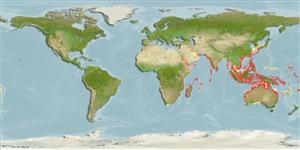Common names from other countries
Environment: milieu / climate zone / depth range / distribution range
Ökologie
seewasser; brackwasser riff-verbunden; tiefenbereich 1 - 50 m (Ref. 90102). Tropical
Indo-Pacific: Red Sea (Ref. 33390) and East Africa to Papua New Guinea (Ref. 9710), north to southern Japan, south to Australia.
Size / Gewicht / Alter
Maturity: Lm ? range ? - ? cm
Max length : 300 cm TL Männchen/unbestimmt; (Ref. 9710)
Rückenflossenstacheln (insgesamt) : 0; Rückenflossenweichstrahlen (insgesamt) : 0; Afterflossenstacheln: 0; Afterflossenweichstrahlen: 0; Wirbelzahl: 138 - 144. Basically white with black blotches and interspaces forming a honeycomb pattern (Ref. 30404, 48635). Some individuals have a near black overall appearance (Ref. 48635). Blotches variable between individuals and size, often in relation to habitat - those in clear coral reefs usually have proportionally less black than those found in turbid waters (Ref. 30404).
Inhabits reef flats and outer reef slopes of continental reefs (Ref. 9710). One of the two largest of Indo-Pacific morays. Often in holes with cleaner wrasses or shrimps (Ref. 48635). Feeds on cephalopods and small fishes (Ref. 30573). Large adults may be aggressive (Ref. 9710). Minimum depth reported taken from Ref. 30573.
Life cycle and mating behavior
Maturities | Fortpflanzung | Spawnings | Egg(s) | Fecundities | Larven
Chen, H.-M., K.-T. Shao and C.T. Chen, 1994. A review of the muraenid eels (Family Muraenidae) from Taiwan with descriptions of twelve new records. Zool. Stud. 33(1):44-64. (Ref. 6934)
IUCN Rote Liste Status (Ref. 130435)
CITES (Ref. 128078)
Not Evaluated
Bedrohung für Menschen
Reports of ciguatera poisoning (Ref. 4537)
Nutzung durch Menschen
Fischereien: weniger kommerziell; Aquarium: Öffentliche Aquarien
Tools
Zusatzinformationen
Download XML
Internet Quellen
Estimates based on models
Preferred temperature (Ref.
115969): 24.5 - 29.1, mean 28.1 (based on 1258 cells).
Phylogenetic diversity index (Ref.
82804): PD
50 = 0.5000 [Uniqueness, from 0.5 = low to 2.0 = high].
Bayesian length-weight: a=0.00035 (0.00021 - 0.00058), b=3.27 (3.13 - 3.41), in cm Total Length, based on LWR estimates for this species & Genus-body shape (Ref.
93245).
Trophic level (Ref.
69278): 4.4 ±0.51 se; based on food items.
Widerstandsfähigkeit (Ref.
120179): sehr niedrig, Verdopplung der Population dauert mehr als 14 Jahre. (Preliminary K or Fecundity.).
Fishing Vulnerability (Ref.
59153): Very high vulnerability (90 of 100).
